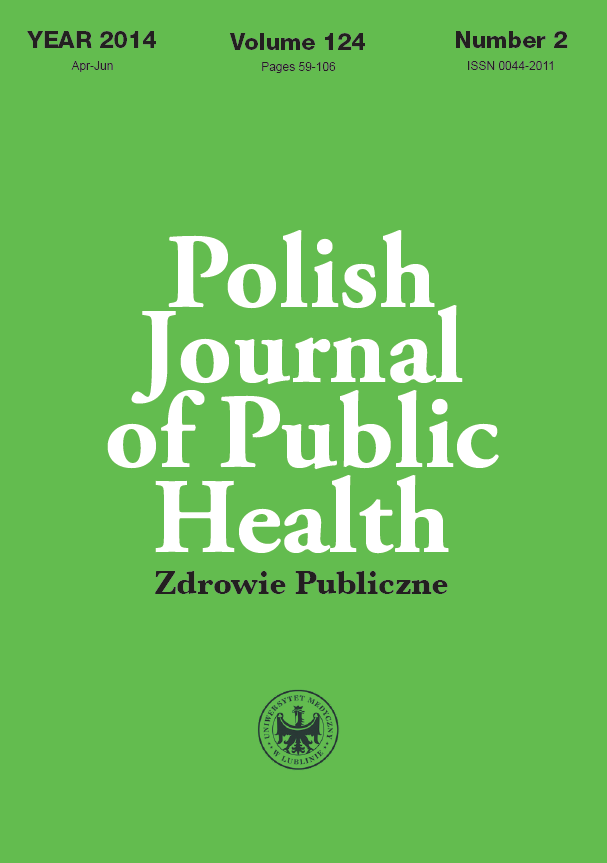Orthodontic treatment – complications and preventive measures
DOI:
https://doi.org/10.2478/pjph-2014-0024Słowa kluczowe:
orthodontic treatment, complications, prophylaxisAbstrakt
Orthodontic treatment aims at restoring correct occlusion and chewing function and improving the aesthetics of the dentition and facial esthetics of the patient. During treatment complications may occur. Most frequently observed complications have been described in the paper. There role of the orthodontist in the therapeutic process and the principles on which doctor- patient cooperation should be based in order to achieve a therapeutic success have been presented. Particular emphasis has been put to the importance of prevention of dental caries and periodontal diseases in orthodontic patients.Bibliografia
1. Staudt CB, Lussi A, Jacquet J, et al. White spot lesions around brackets: in vitro detection by laser fluorescence. Eur J Oral Sci. 2004;112:237-43.
2. Demling A, Heuer W, Elter C, et al. Analysis of supra- and subgingival long-term biofilm formation on orthodontic bands. Eur J Orthod. 2009;31:202-6.
3. Śmiech-Słomkowska G, Strzecki A. Wpływ leczenia aparatami stałymi na formowanie biofilmu w jamie ustnej. Forum Ortod. 2009;5(4):104-17.
4. Jabłońska-Zrobek J, Śmiech-Słomkowska G. Ryzyko próchnicy podczas leczenia ortodontycznego aparatem stałym. Czas. Stomat. 2005;58(7):514-9.
5. Mattousch TJ, van der Veen MH, Zentner A. Caries lesions after orthodontic treatment followed by quantitative light-induced fluorescence: a 2-year follow-up. Eur J Orthod. 2007;29:294-8.
6. Kidd EA, Fejerskov O. What constitutes dental caries? Histopathology of carious enamel and dentin related to the action of cariogenic biofilms. J Dent Res. 2004;83(Spec No C):C35-38.
7. Chapman JA, Roberts WE, Eckert GJ, et al. Risk factors for incidence and severity of white spot lesions during treatment with fixed orthodontic appliances. Am J Orthod Dentofacial Orthop. 2010;138:188-9.
8. Bielaczyc A, Herud B. Resorpcja korzeni zębów po leczeniu ortodontycznym na podstawie piśmiennictwa. Czas Stomatol. 1995;48(8):542-6.
9. Bielaczyc A, Herud B, Szafrańska A. Patogeneza resorpcji korzeni zębów w leczeniu ortodontycznym na podstawie piśmiennictwa. Czas Stomatol. 1996;49(3):200-5.
10. Filho PFG et al. Orthodontically induced inflammatory root resorptions: a case report. Dent Traumatol. 2006;22:350-3.
11. Dominiak M, Konopka T, Szajowski K. Recesje dziąseł w odniesieniu do potencjalnych czynników etiopatologicznych. Stomatol Współcz. 2002;9(2):22-8.
12. Gackowska M, Łuczkowska A, Kalukin J. Wpływ leczenia ortodontycznego na występowanie recesji tkanek przyzębia. Por Stomatol. 2006;8:12-6.
13. Górniak D, Grzywacz I. Zasady postępowania w skojarzonym leczeniu periodontologiczno-ortodontycznym pacjentów dorosłych. Ortod Współcz. 2002;4(2):39-42.
14. Pietrzyk M, Górniak D, Jabłońska E. Recesje przyzębia i higiena jamy ustnej u pacjentów leczonych aparatami stałymi i ruchomymi. Czas Stomatol. 1996;49(9):636-40.
15. Szymańska-Kubal D. Wybrane powikłania leczenia ortodontycznego aparatami stałymi i ruchomymi. Nowa Stom. 1999;3(1/2):31-40.
16. Pietrzyk M, Bielawska H, Górniak D. Wczesne powikłania leczenia ortodontycznego pacjentów młodocianych. Mag Stomat. 2002;12(10): 8-12.
17. Marbach J , Raphael KG, Janal MN et al. Reliability of clinician judgements of bruxism. J Oral Rehabil. 2003;30:113-8.
18. Panek H. Badania nad zależnościami czynnościowo-morfologicznymi układu stomatognatycznego ze szczególnym uwzględnieniem modeli funkcjonalnych zgryzu. Rozprawa habilitacyjna. Wrocław: AM; 2002.
19. Winocur E, Gavish A, Volfin G, et al. Oral motor parafunctions among heavy drug addicts and their effects on signs and symptoms of temporomandibular disorders. J Orofac Pain. 2001;15:56-63.
20. Siemińska-Piekarczyk B, Zadurska M, Biedrzycka E, et al. Etiologia i objawy kliniczne bruksizmu u dzieci i młodzieży na podstawie piśmiennictwa i własnych obserwacji. Czas Stomatol. 1998;51(1):47-51.
21. Benson PE, Shah AA, Millett DT, et al. Fluorides, orthodontics and demineralization: a systematic review. J Orthod. 2005;33:103-14.
22. Demito CF, Vivaldi-Rodriguez G, Ramos AL, et al. The efficacy of a fluoride varnish in reducing enamel demineralization adjacent to orthodontic brackets: an in vitro study. Orthod Craniofac Res. 2004;7:205-10.
23. Stecksén-Blicks C, Renfors G, Oscarson ND, et al. Caries-preventive effectiveness of a fluoride varnish: a randomized controlled trial in adolescents with fixed orthodontic appliances. Caries Res. 2007;41:455-9.
24. Benham AW, Campbell PM, Buschang PH. Effectiveness of pit and fissure sealants in reducing white spot lesions during orthodontic treatment: A Pilot study. Angle Orthod. 2009;79:338-45.
25. Bailey DL, Adams GG, Tsao CE, et al. Regression of post-orthodontic lesions by a remineralizing cream. J Dent Res. 2009;88:1148-53.
26. Lata S, Varghese NO, Varughese JM. Remineralization potential of fluoride and amorphous calcium phosphate-casein phosphopeptide on enamel lesions: An in vitro comparative evaluation. J Conserv Dent. 2010;13(1):42-6.
27. Willmot D. White spot lesions after orthodontic treatment. Semin Orthodont. 2008;14:209-19.


